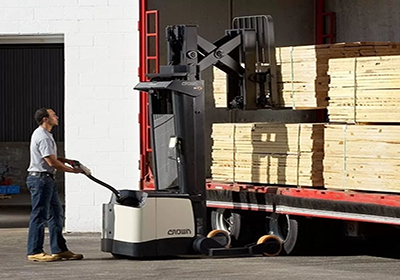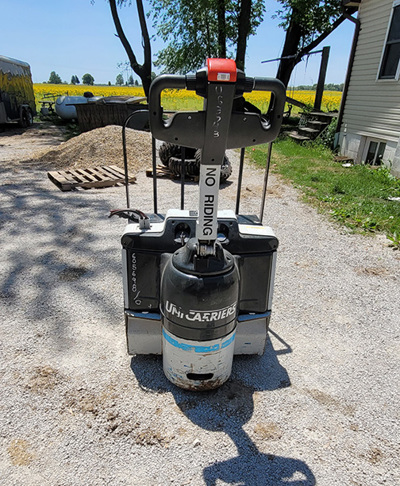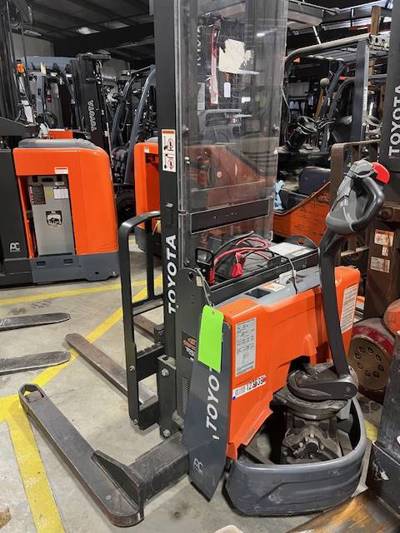What Is a Walkie Stacker Used For?
A walkie stacker, also known as a walk-behind stacker or pedestrian stacker, is a type of powered pallet truck designed for lifting, stacking, and transporting palletized loads in warehouses, distribution centers, and manufacturing facilities. These compact and maneuverable machines are typically used for tasks such as loading and unloading trucks, stacking pallets in storage racks, and moving materials within confined spaces. Walkie stackers are ideal for environments where space is limited or where larger forklifts cannot operate efficiently. They are commonly employed in retail, logistics, and manufacturing industries to streamline material handling operations, improve warehouse efficiency, and reduce manual labor. With their ability to lift and stack loads vertically, walkie stackers contribute to optimizing storage space and enhancing productivity in various workplace settings.
How Does a Walkie Stacker Work?
A walkie stacker operates using an electric motor to provide power for lifting, lowering, and maneuvering palletized loads.
Power Source: Walkie stackers are powered by rechargeable batteries, which provide the necessary energy for the electric motor to operate.
Control Panel: The operator controls the walkie stacker using a control panel or handlebar located at the rear of the machine. The control panel features buttons or levers for controlling the direction, speed, and lifting/lowering functions.
Maneuvering: To move the walkie stacker, the operator walks behind the machine and grips the handlebar. By pushing or pulling the handlebar in the desired direction, the operator can steer the walkie stacker around the workspace.
Lifting: To lift a load, the operator positions the forks of the walkie stacker underneath the pallet. They then use the controls to activate the lifting mechanism, which raises the forks and the load off the ground.
Transporting: With the load lifted, the operator can then maneuver the walkie stacker to transport the palletized goods to their destination. The walkie stacker can navigate tight aisles and confined spaces with ease due to its compact size and maneuverability.
Stacking: Once at the desired location, the operator can use the controls to lower the forks and deposit the load onto a storage rack or onto the ground. If stacking multiple pallets, the operator can repeat the lifting and stacking process as needed.
How High Can a Walkie Stacker Go?
Walkie stackers typically have a lifting height ranging from 8 to 15 feet, depending on the specific model and manufacturer.
What Class is a Walkie Stacker?
A walkie stacker typically falls under Class 3 in the classification system established by the Industrial Truck Association (ITA).
Do You Need a Forklift License for a Walkie Stacker?
Generally, you don’t need a forklift license specifically for a walkie stacker. However, regulations regarding the operation of walkie stackers vary depending on the jurisdiction and workplace policies. In many cases, operators are required to undergo training and certification specific to the equipment they will be operating, including walkie stackers.
Even though walkie stackers are typically smaller and operated while walking behind them, they still require proper training to ensure safe operation, particularly in environments where pedestrians or other equipment may be present. It’s important to follow the guidelines and regulations set forth by your local authorities and workplace safety protocols to ensure the safe operation of walkie stackers.
How Much Does It Cost to Ship a Walkie Stacker?
Because of their weight and the space required for forks, shipping a Walkie Stacker will cost you about $3.80 per mile east of the Mississippi in 2023. Need a shipping quote? Click on “Get A Shipping Quote” on the unit you are interested in on FleetNow.
How Long Does a Walkie Stackers Last?
The item most prone to failure in a walkie stacker is the battery. A battery can be expected to last for at least five years. By carefully managing the battery – recharging it when it falls to 25-30% of power, charging it until it is nearly full, and carefully cleaning it according to the manufacturer’s recommendations – its life can be extended considerably. A properly maintained walkie stacker can last for ten years or more.

What Are Popular Brands of Walkie Stackers for Sale?
Hyster-Yale: Hyster-Yale manufactures durable walkie stackers designed to handle a variety of material handling tasks with ease. Their machines are praised for their robust construction, advanced technology, and versatility in warehouse operations.
Mitsubishi: Mitsubishi walkie stackers are known for their precision, durability, and efficiency. These machines feature ergonomic designs and intuitive controls, making them easy to operate and enhancing productivity in material handling applications.
Raymond: Raymond walkie stackers are renowned for their durability, performance, and reliability. Their machines are equipped with advanced features such as regenerative braking and intelligent performance systems, providing efficient and safe operation in warehouse settings.
Toyota: Toyota walkie stackers are recognized for their quality, innovation, and operator comfort. These machines are designed with ergonomic features and advanced technology to maximize productivity and minimize downtime in material handling operations.
Shop for Walkie Stackers for Sale on BuyFleetNow.com
Hyster-Yale Walkie Stackers For Sale | Mitsubishi Walkie Stackers For Sale | Raymond Walkie Stackers For Sale | Toyota Walkie Stackers For Sale
What Should I Look for When Purchasing a Walkie Stacker for Sale?
When shopping for a walkie stacker for sale, consider factors such as lifting capacity, lift height, maneuverability, battery life, and ergonomic features. Ensure the walkie stacker can handle the maximum weight of your loads and has a lift height suitable for your storage racks. Look for models with good maneuverability, allowing easy navigation in tight spaces. Battery life is crucial for uninterrupted operation, so opt for models with long-lasting batteries and quick charging times. Lastly, prioritize ergonomic features like adjustable controls and cushioned handlebars to enhance operator comfort and reduce fatigue during long shifts.
What’s the Difference Between a Forklift and a Walkie Stacker?
Forklifts are larger and require more room to maneuver than walkie stackers. A walkie stacker is similar to a pallet jack, with the added benefit of being able to lift a load for storage or retrieve one without the use of a forklift. While forklifts can be purchased with a variety of power choices, including diesel, LP, and electric, walkie stackers are usually electric powered.
Video: Raymond Walkie Pallet Stacker Overview
Recent Equipment News
MEC MME25 Review: Specs, Features & Industry Perspective
MEC MME25 Review: Specs, Features & Industry [...]
Help Name FleetNow’s New Rental Platform—Get a Free Shirt That’ll Turn Heads on the Jobsite
A new rental + inventory platform is coming–built by [...]
Construction Equipment Trends 2025: Inside Q1–Q2 Demand & What It Means for You
Table of Contents Top 10 Categories Q1 vs [...]






































